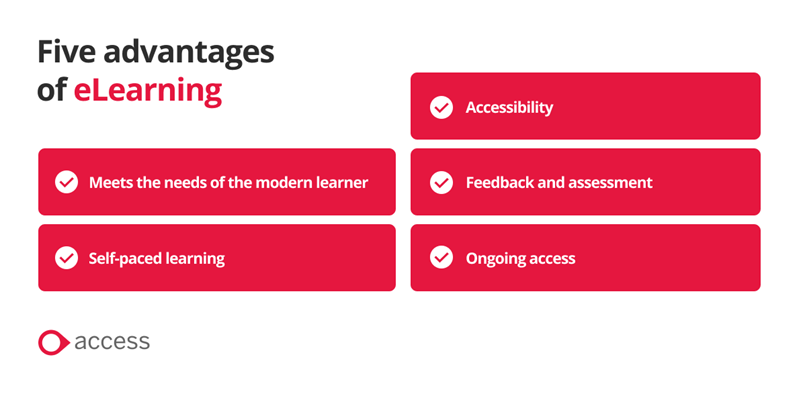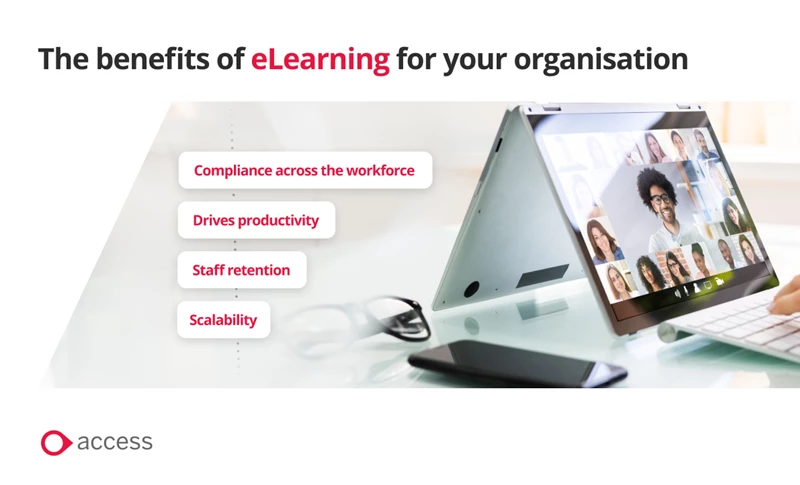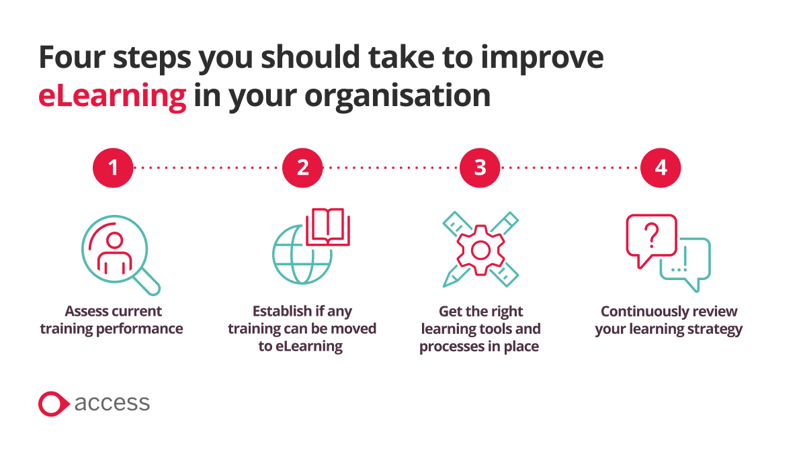-
- Learning Management System
- Learning Management System
- eLearning Courses
- Gamified Learning Solutions
- Content creation software
-
- eLearning Courses
- eLearning Courses
- Compliance eLearning
- Compliance eLearning for Financial Services
- Cyber Security Awareness eLearning
- Health & Safety eLearning
- Mental Health & Wellbeing eLearning
- Workplace Skills and Personal Development eLearning
- Online teaching resources for schools
- Self Directed Learning

What are the benefits of eLearning?
Over recent years, eLearning has emerged as a popular method of learning in the workplace. There are plenty of ways that eLearning can positively influence both your organisation’s L&D goals and employee’s training needs.
In this article we are going to discuss the benefits of eLearning for employees, your organisation and the environment.
 7 minutes
7 minutes

Written by Richard Whittington, Senior Product Manager
In this article we are going to explore:
- Disadvantages of classroom learning
- The benefits of eLearning for employees
- Is eLearning effective for employees?
- The benefits of eLearning for your organisation
- The benefits of eLearning for the environment
- How to improve eLearning in four steps
- Reap the benefits of eLearning for employees and beyond
What is eLearning?
eLearning, short for electronic learning, is the method of delivering training using electronic media and the internet It involves accessing educational content, courses, or training programs online, allowing individuals to learn at their own pace.
You can read more in our What is eLearning? article.
Three disadvantages of classroom learning:
Before we talk about the benefits eLearning can offer, it's essential to first understand why traditional classroom learning methods may fall short in meeting the evolving needs of modern learners.
Here are three limitations of traditional classroom learning:
- Limited catering to diverse learning needs:
Traditional classroom learning often follows a one-size-fits-all approach, which can be challenging for individuals with diverse learning preferences. This means it may not effectively accommodate the different ways people learn best. - Rigid adherence to fixed schedules:
Classroom-based training is bound by fixed schedules and timelines, making it inflexible for learners who have varying time constraints and commitments. This rigidity can lead to missed training opportunities for those who cannot attend during the designated time. - Geographical confinement:
Learners are required to be physically present in a specific location, which can be a significant barrier for organisations with large teams who are based at home which could be anywhere in the country. It also limits access for international employees and can be costly in terms of travel expenses.
The benefits of eLearning for employees - Five advantages of eLearning
As we have discussed already, the needs of the learner should be a priority for your organisation. The delivery of learning content via electronic media using the internet allows organisations to provide the right training to their employees in the flow of work and at the time it is needed. This learner-centric approach offers several key benefits to employees, fostering a more effective and engaging learning environment.
Here are five advantages of eLearning for the employee:

1. Meets the needs of the modern learner
eLearning is a powerful tool that caters to diverse learning preferences. While everyone learns online, eLearning offers a range of media formats, such as videos, online courses, gamification and interactive modules, making it adaptable to all online learning needs.
2. Self-paced learning
Unlike traditional classroom learning, eLearning enables employees to engage in bite-size training at their own pace, which is sometimes referred to as microlearning. This approach enhances flexibility, allowing individuals to schedule their learning at their convenience. It also ensures that employees can access the relevant information precisely when they need it the most.
3. Accessible
One of the most significant advantages of eLearning is its accessibility. Removing the need for physical locations and specific times means that the learning can be accessed easily (provided a device and an internet connection are available), regardless of location or time zone. Whether an employee is at the office, working remotely, or on the go, they can access eLearning modules with ease via a computer or by a tablet or smart phone via an eLearning mobile app.
4. Feedback and assessment
eLearning platforms provide the capability to offer instant feedback and assessments to employees, which can be a powerful motivator. When employees receive immediate feedback on their performance, it gives them a sense of purpose and accomplishment. This sense of achievement encourages them to continue their eLearning journey with enthusiasm.
5. Ongoing access
When there is a lot of important information to process, it isn’t always easy to take it in within a short timeframe. This is why an eLearning system can help because the learning within it can be accessed more than once. It also provides a single source of truth which, for topics like health and safety, there are crucial elements to be aware of and up to date with.
eLearning is a vital part of your learning and development strategy. Speak to one of our online learning experts to learn more.
Is eLearning effective for employees?
The recent Learning at Work report carried out by the CIPD found that organisations are encouraging individuals to take ownership for their learning but are less likely to create an environment that provides permission and opportunity to learn.
When employees are given the trust and autonomy to learn the way they find most beneficial to them, they are far more likely to embrace it and take charge of their training needs.
When utilised at an organisational level, eLearning gives companies the power to push the most relevant training out to a large number of employees. Building suitable pathways for new starters or job specific content for recent role changes means that the right curriculum can be followed and kept on top of.
This way of learning goes beyond the conventional classroom model. It signifies a cultural shift towards continuous learning, where knowledge and training are not confined to specific timeframes or rigid structures. Instead, eLearning promotes a dynamic and adaptive approach to employee development.
The benefits of eLearning for your organisation
There are many ways that eLearning can benefit an organisation. Below are some advantages of eLearning that your organisation can leverage to enhance its workforce, streamline training processes, and achieve its L&D goals more effectively.
1. Compliance across the workforce
Ensuring compliance with industry regulations, company policies, and legal requirements is essential for any organisation and the cost of non-compliance can be detrimental.
eLearning courses provide standardised information to all employees, reducing the risk of misinterpretation.
A Learning Management System (LMS) will usually include tracking features that allow organisations to monitor and document employee progress, ensuring that everyone is up to date with compliance requirements.
2. Drives productivity
eLearning plays a pivotal role in enhancing organisational productivity.
By providing employees with flexible and accessible training options, eLearning minimises disruptions to daily work routines, enabling them to choose when and where they learn.
This self-paced approach ensures that employees can be more productive during working hours whilst still getting the training they need.
3. Staff retention
When employees have access to training and skill development opportunities, they are more likely to feel engaged and invested in their roles, reducing the chances of turnover.
Business News Daily recently reported that a big factor in managing and improving employee retention rate lies in giving employees clear growth opportunities.
eLearning tools can provide a clear path for employees to acquire new skills and qualifications, leading to potential career growth.
4. Scalability
eLearning offers scalability benefits that can accommodate organisational growth and evolving training needs.
For the training of new hires, utilising an eLearning platform allows organisations to easily scale training to accommodate a growing workforce, reducing the time and resources required for onboarding.

The benefits of eLearning for the environment
Now we have discussed how eLearning can positively impact both your organisation and your employees, let’s touch upon the positive environmental impact eLearning can have. As organisations strive for sustainability and environmental responsibility, eLearning emerges as a pivotal tool aligning professional development with eco-conscious practices.
Firstly, rolling out eLearning to your employees removes the need for material resources. This means for important updates, changes can be easily actioned without the need for wasted and outdated materials that will need to be disposed of. This is particularly crucial for topics such as compliance training where organisations must adhere to relevant laws, regulations, and industry standards.
Another benefit to the environment is that it reduces pollution and emissions. With traditional classroom learning usually requiring travel to a specific location resulting in a higher carbon footprint. However, utilising an eLearning platform alleviates this by giving employees access to training materials from anywhere as long as they have internet access.
How to improve eLearning in four steps
If you are at the beginning stages of your eLearning journey or want to make it a wider offering to your workforce then you may need to follow some steps. Below are the four steps you should take to improve eLearning in your organisation and to ensure it aligns with organisational goals.

1. Assess current training performance
It is important to complete a thorough assessment of your current training offerings in order to spot any opportunities for change or any gaps that need to be filled. Consider the following questions:
- Are you providing the breadth and depth of training required for your workforce?
- Are your courses up to date and are the regulatory topics reviewed and renewed by the training provider?
- Is the content engaging with bitesize modules, varied formats and a human centric approach?
If you have answered these questions and identified any areas that could be improved on or reviewed further, then this is a great opportunity to make some positive changes to the training you offer.
2. Establish if any training can be moved to eLearning
The next step is to find out if any current training can be turned into eLearning. Offering short bursts of information in an easily digestible format can transform tricky topics into something that employees want to learn and actively seek out. For mandatory topics such as compliance, pushing out training in these bitesize chunks will make them more likely to stick which can be crucial.
3. Get the right learning tools and processes in place
To maximise the effectiveness of your eLearning, you should consider which tools will be beneficial. A Learning Management System (or LMS) is a platform which gives employees access to your eLearning content library. An LMS will also track progress, keep everything in one place and allows organisations to offer eLearning to a large number of employees without diminishing the quality of training. eLearning can be introduced without the need for an LMS, but processes must be in place to to successfully roll it out to your employees.
4. Continuously review your learning strategy
Once you have made these changes and set up your LMS, or management processes, you can ensure your eLearning fits in with organisational goals. The monitoring and reporting tools within an LMS can help identify how your eLearning is being consumed, the effectiveness of particular modules and any opportunities for further improvement going forward. For those without an LMS, you should plan how you will report on success and what data is needed to review this.
Reap the benefits of eLearning for employees and beyond
As we have discussed within this article, there are plenty of benefits to eLearning at an organisational, employee and environmental level. Utilising eLearning within your organisation can help with rolling out the right information to the necessary people when they need it most. By implementing some of the processes we have outlined, you can ensure you and your workforce are getting the most out of eLearning and meeting your overarching L&D goals.

